Web3 smartphones are on the rise, categorized into three types: Web3-supporting, Web3-focused, and native Web3. While they have the potential to enhance user access and address mobile market cost issues, they still face challenges such as insufficient hardware performance, over-reliance on airdrops, and operational hurdles.
Authors: Leo Park, Jay Jo, and Yoon Lee
Translation: Blockchain in Plain Language

Key Summary:
Recently, a large number of Web3-supporting smartphones have been released, attracting significant attention. These phones can be categorized based on their level of Web3 integration: 1) Web3-supporting, 2) Web3-focused, 3) native Web3 smartphones.
Web3 smartphones are expected to improve user access to Web3 services while addressing high costs in the mobile market. However, concerns remain regarding over-reliance on airdrop marketing rather than innovation, and weak hardware performance.
Traditional smartphone manufacturers like Samsung have utilized Web3 technology for one-off promotions, but the broader potential for Web3 integration in their devices continues to grow.
In recent years, Web3-supporting smartphones have garnered widespread attention in the industry. These devices serve as terminals for the public to engage with new technologies, becoming powerful tools for driving Web3 into the mainstream market. This article will explore the current state of Web3 smartphones and look ahead to their future development.
1. Classification of Web3 Smartphone Projects
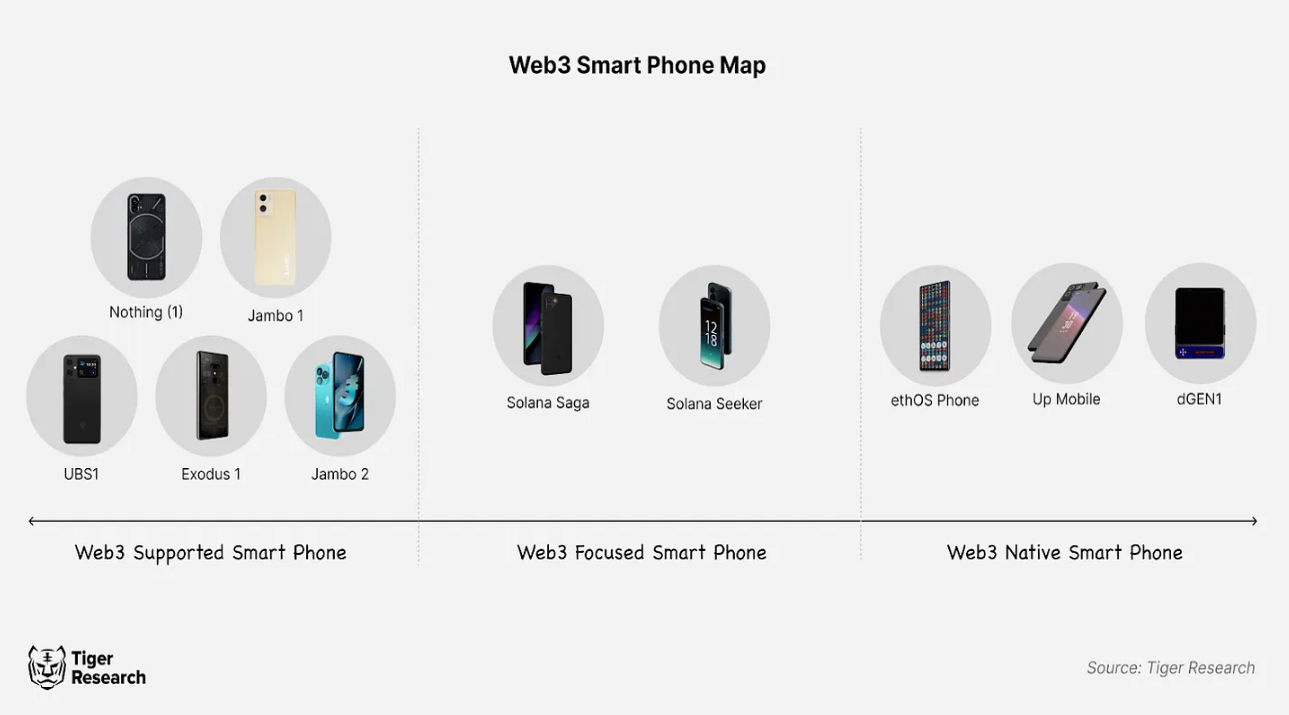
Web3 smartphone projects are distinguished based on the application level of Web3 technology. Tiger Research categorizes Web3 smartphones to be released by October 2024 into three types: 1) Web3-supporting smartphones, 2) Web3-focused smartphones, 3) native Web3 smartphones.
These classifications are based on the level of integration of Web3 technology.
1) Web3-supporting Smartphones
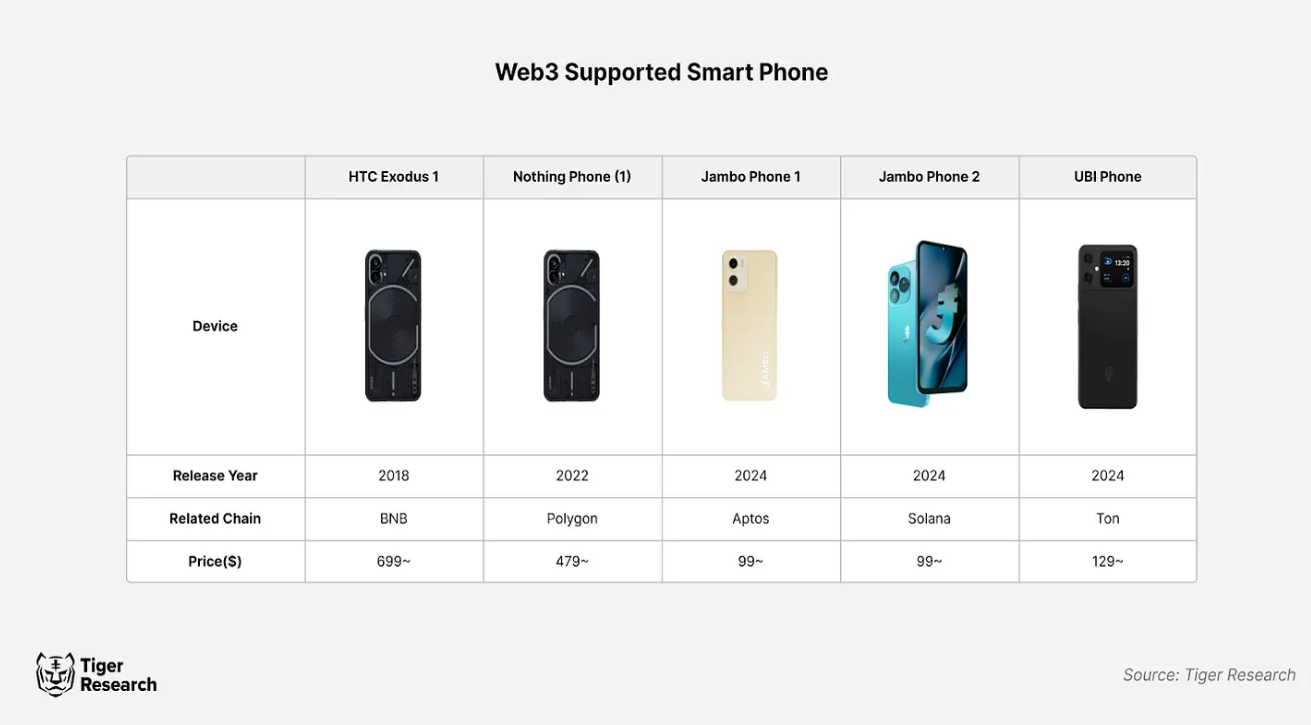
Web3-supporting smartphones are functionally similar to traditional smartphones but only support Web3 technology at a basic level. These devices primarily come equipped with Web3 wallet applications, such as Metamask and Petra, as well as cryptocurrency trading platform applications. They introduce Web3 elements through experimental collaborations with blockchain mainnets to expand their ecosystems.
In most cases, no special Web3 technology is applied. Users can achieve a similar experience by installing Web3 applications on regular smartphones. Therefore, these devices do not offer unique value, and user interest quickly wanes. A typical example is the startup smartphone manufacturer Nothing, which collaborated with Polygon to launch an NFT community and a Polygon-based identity system but has recently terminated most of these services.
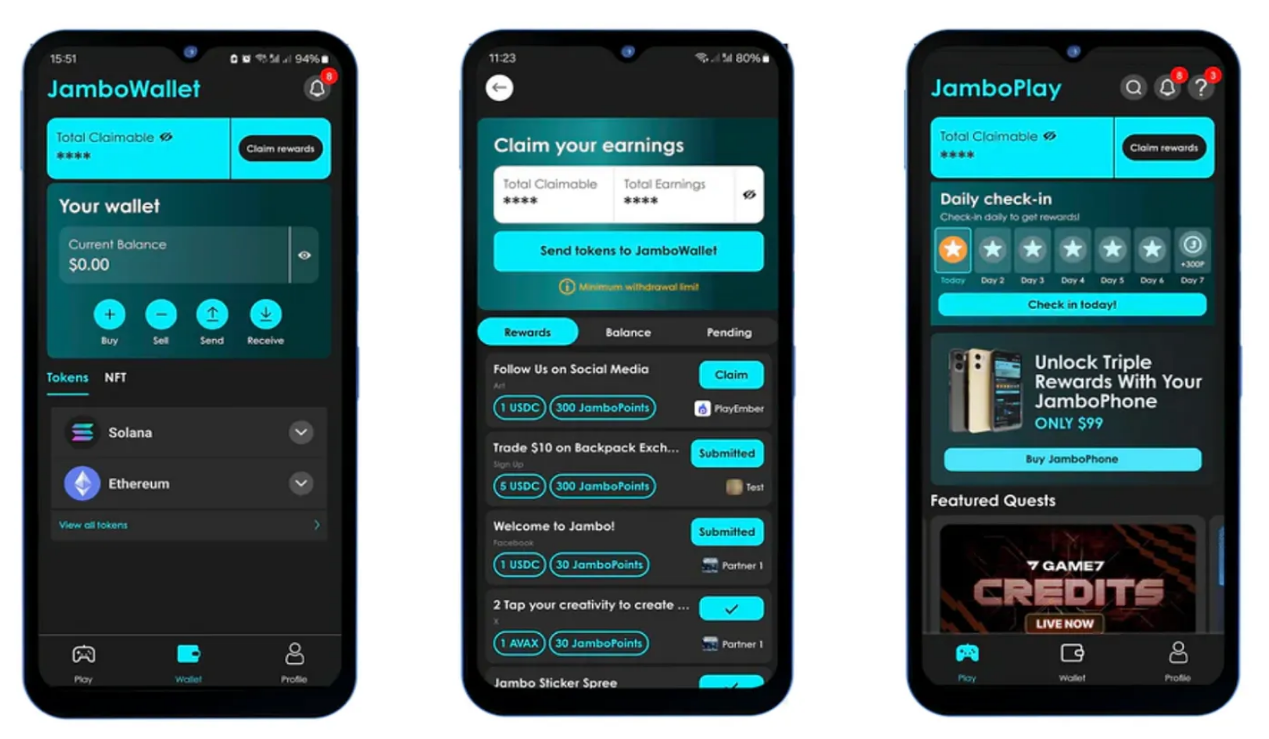
Source: Jambo Phone
Recent cases have shown more positive applications of Web3 elements. For example, Jambo Phone comes pre-installed with Web3 wallet Petra and cryptocurrency trading platform OKX applications. It also guides users into the Web3 ecosystem through its own application, Jambo Play. Users can participate in Web3 project tasks and earn cryptocurrency rewards through this app. This approach provides a lightweight testing platform and collaboration model for projects. We expect to see more similar examples in the future.
2) Web3-focused Smartphones
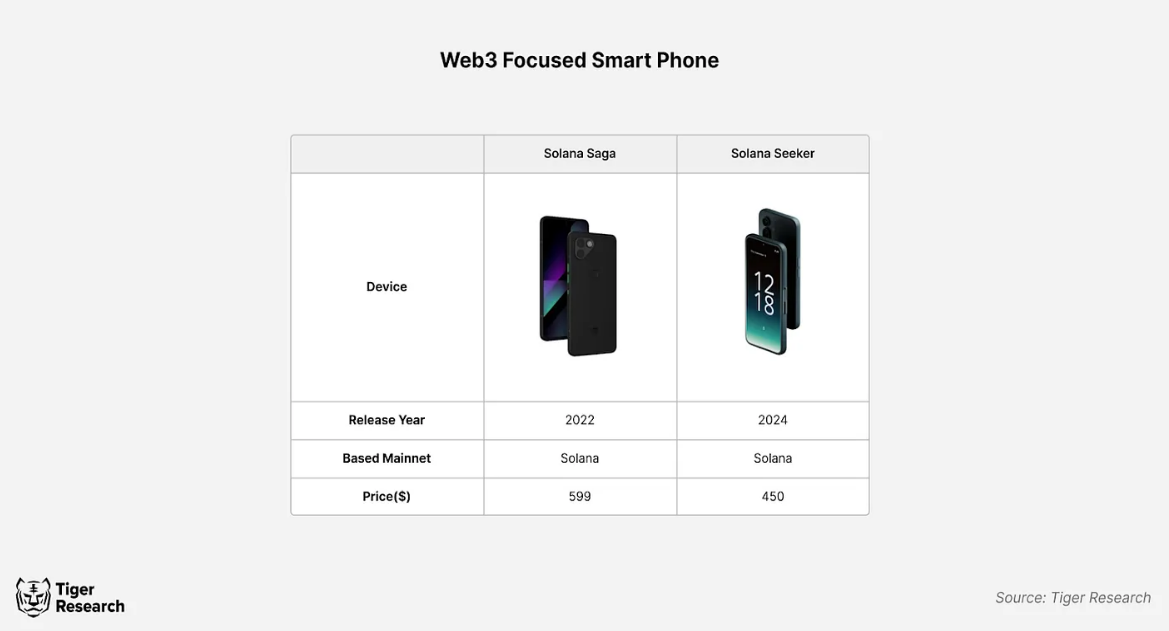
Web3-focused smartphones partially integrate Web3 technology into their device systems. These phones run traditional mobile operating systems with added Web3 features, providing a moderate level of integration rather than full Web3 capabilities. Typical examples include Solana's first-generation Saga and the recently announced second-generation Seeker.
These Web3-focused smartphones connect the traditional mobile environment with the Web3 ecosystem through dedicated programming interfaces. Solana provides the Solana Mobile Stack (SMS) to help developers build Web3 services. The phones are also equipped with Web3 optimization tools, such as the Solana Pay system, utilizing Android's NFC capabilities and QR codes, as well as a seed vault for enhanced security.
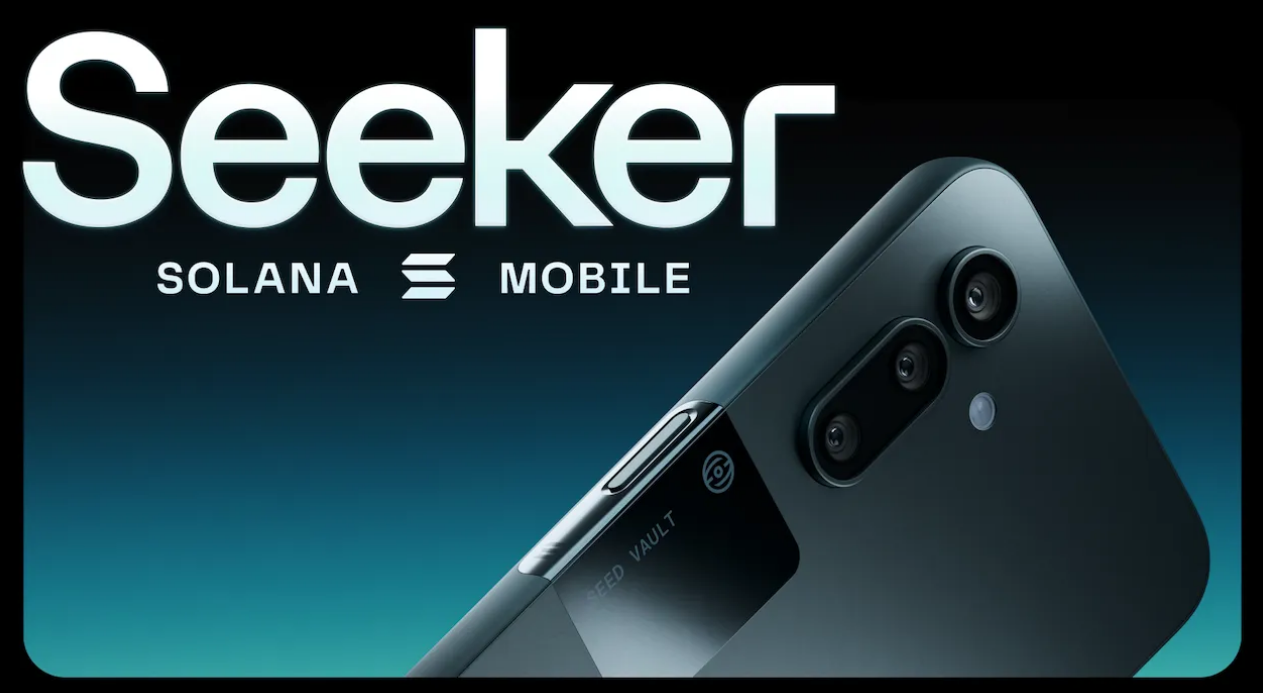
Solana Seeker, Source: Solana Mobile
However, these Web3-focused smartphones still fall short of providing a complete native Web3 experience. Users need to install separate Web3 wallets or use dedicated browsers like Brave to access Web3 services. The Seeker, developed in collaboration with Solflare, includes a built-in seed vault wallet as a feature. Many undisclosed features may still make it a true native Web3 smartphone.
3) Native Web3 Smartphones
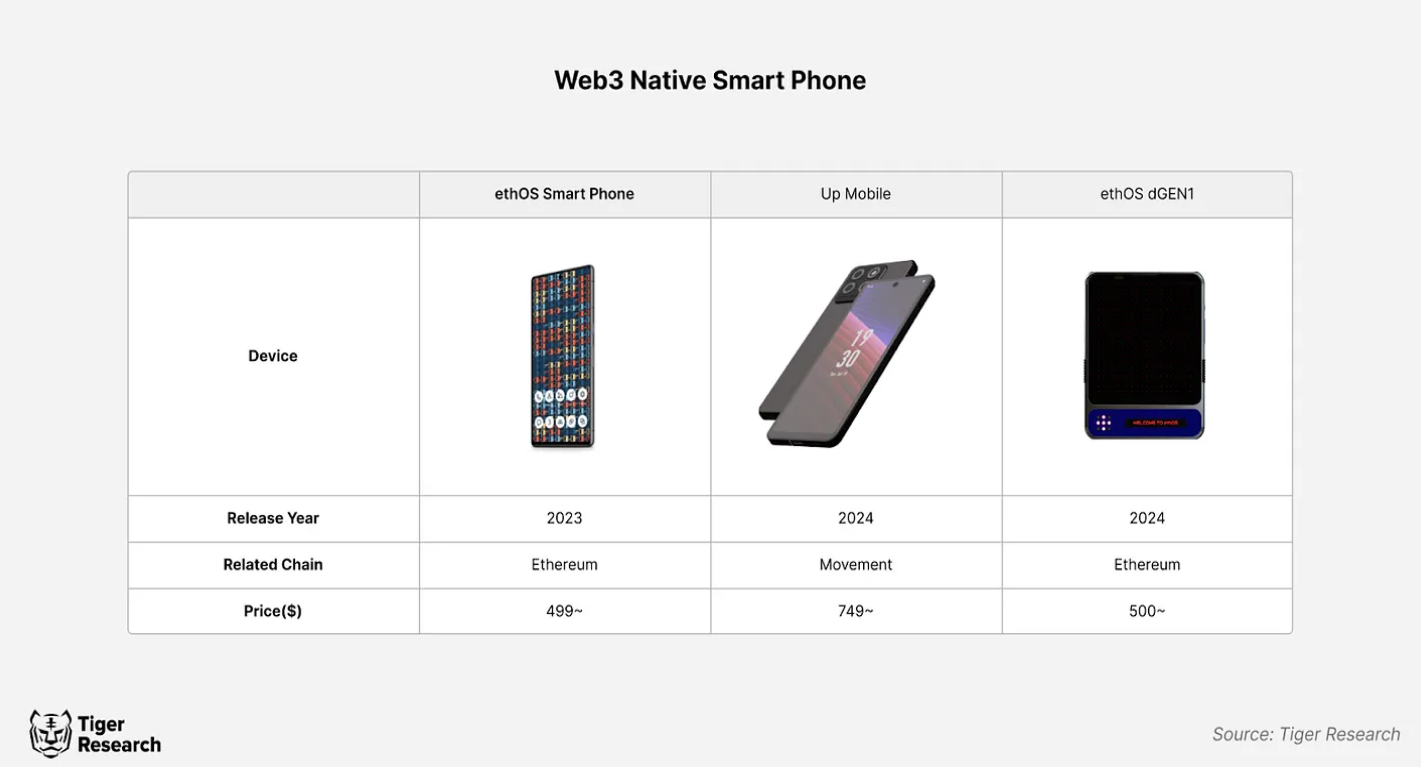
This is achieved through the use of their own Web3 operating systems or by providing native support for core Web3 technologies, such as peer-to-peer distributed file systems (IPFS), Web3 messaging protocols (XMTP), and blockchain-based naming systems (CNS). These smartphones also include a light node client on the device, allowing users to verify transactions independently.

ethOS Nouns version (left), dGEN1 (right) Source: ethOS
A notable example is Freedom Factory's ethOS. In 2023, with the support of NounsDAO, ethOS released its first prototype smartphone. This device introduced an Ethereum-based Web3 operating system, achieving system-level comprehensive integration. Recently, the company launched the dGEN1 smartphone, enhancing its native Web3 capabilities. The built-in ethOS browser supports IPFS and ENS. Its light node client functionality allows users to run decentralized applications (dApps) on-chain without relying on external RPC nodes. The integrated Web3 wallet in the operating system enables users to sign transactions without switching applications or using in-app browsers. The device also offers advanced features such as SMS-based cryptocurrency transfers and the option to mint gallery images as NFTs.

Source: Up Network
Similarly, Up Mobile, developed in collaboration with Movement Labs and Up Network, showcases a high level of Web3 integration. Its proprietary Web3 operating system, Up OS, provides system-level integration. The device's built-in Web3 wallet supports light node functionality and headless signing technology.
2. What Advantages Do Web3 Smartphones Bring?
Interest in Web3 smartphone projects is steadily growing, with various experiments underway. This upward trend stems from expectations that Web3 smartphones will play a key role in driving the mass adoption of Web3 technology while addressing challenges in the existing industry. The advantages of Web3 smartphones can be analyzed from the following three aspects:
First, Web3 smartphones can significantly enhance accessibility to Web3 services through the advantages of portable devices. With built-in Web3 wallets, private key management, and decentralized application (dApp) services, users can easily access Web3 services anytime and anywhere. This synergy between Web3 technology and financial services is particularly noteworthy. Through these devices, users can access crypto-asset-based financial services without time and location constraints, potentially making financial services more accessible in developing countries with limited infrastructure.
Second, Web3 smartphones are expected to address long-standing issues in the mobile market. Currently, centralized app store fees can be as high as 30%. This reduces developers' profits and limits market growth. Web3 smartphone projects aim to tackle these issues through decentralized alternatives. For example, Solana Mobile and Up Network are developing decentralized dApp stores based on blockchain infrastructure. Their goal is to create a decentralized application ecosystem without fees.
Finally, the combination of these two advantages is expected to generate a powerful synergy in the Web3 industry. The demand for consumer applications in the Web3 space is continuously growing, but there is a lack of device environments that support everyday use. Web3 smartphones are expected to overcome this limitation and facilitate the development of new consumer applications. Just as the shift from PCs to mobile devices led to a surge in innovative services, the rise of Web3 smartphones may trigger similar innovations. With the portability of mobile devices and enhanced IT service applications through various sensor functionalities, Web3 smartphones could bring significant disruption to the field. In particular, a no-fee dApp store environment is expected to create a more vibrant development ecosystem than the current Web 2 industry.
3. What Challenges Do Web3 Smartphones Face?
Despite the potential of Web3 smartphones, they still face several challenges. First, their hardware specifications are relatively inferior compared to mainstream smartphones. Most Web3 smartphones lag behind in camera performance and screen refresh rates, making them unsuitable for mainstream use. Additionally, a price point exceeding $500 is too expensive for the specifications offered, making it difficult for average consumers to choose. The phased pre-sale system also creates uncertainty in delivery times, reducing accessibility. Therefore, Web3 smartphones face issues regarding hardware competitiveness, sales, and operational improvements.

Source: Jambo Phone (left), Goosefx (right)
The second issue is that people's interest in Web3 smartphones is more focused on airdrops and other rewards rather than technological innovation. The first Web3 smartphone project from Solana, Saga, clearly exemplifies this. Initially, due to sluggish sales, the price of Saga was reduced. When the value of the payment currency $BONK received by users increased, demand surged, causing the resale value of Saga to skyrocket to $5,000. Pre-orders for its successor, Seeker, have now exceeded 140,000 units. Similarly, Jambo Phone garnered attention by offering the Aptos-based meme coin Gui Inu ($GUI) for free. These examples indicate that the Web3 smartphone market is driven by speculative factors such as free tokens and resale value. This raises concerns that Web3 smartphones may become a short-term trend rather than a sustainable ecosystem.
Finally, Web3 smartphones face operational challenges. One issue is that the decentralized operation of Web3 smartphones may be too radical to fully replace the real value provided by traditional centralized platforms. Although Google Play and the Apple App Store charge up to 30%, they provide necessary services, including preventing abuse and illegal activities, maintaining the application service infrastructure for payments, and offering customer support. The unique dApp experience of Web3 smartphones may also present new user experience challenges. Just as pre-installed applications from manufacturers or telecom providers have frustrated users, the pre-installed blockchain infrastructure and dApp configurations on Web3 smartphones may impose a specific Web3 environment on users based on the interests of manufacturers and partners. Web3 smartphones must not only focus on technological integration but also develop comprehensive operational plans to address these challenges.
4. How Are Traditional Smartphone Manufacturers Responding?
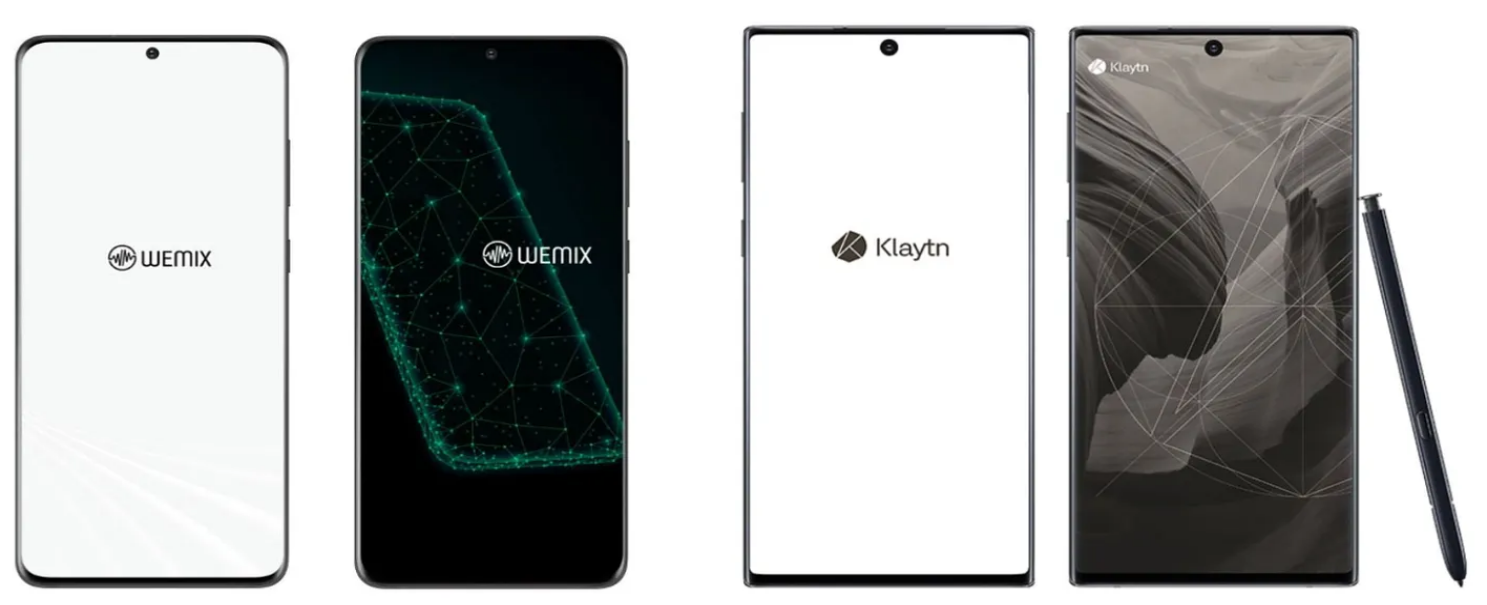
Galaxy S20 Wemix Edition (left), Galaxy Note10 Klaytn Edition, Source: Samsung
Traditional smartphone manufacturers have also shown interest in integrating Web3 technology into their devices. Initially, most efforts were limited to one-off promotional activities, lacking significant differentiation. For example, Samsung collaborated with WeMade Tree (now merged with WeMade) and GroundX (formerly the developer of Klaytn) to launch a series of Web3 smartphones equipped with pre-installed dApps from each mainnet. However, there were no significant features beyond installing basic wallet applications and providing cryptocurrency to buyers.

Source: Envato
However, recent practical applications of Web3 technology have shown good potential. For instance, Circle announced the launch of a "tap payment" feature. This will allow users to make payments using the USDC stablecoin on iPhones, leveraging Apple's NFC technology. Although Apple did not directly develop this feature, it indicates that Web3 payments can be implemented on devices like the iPhone.
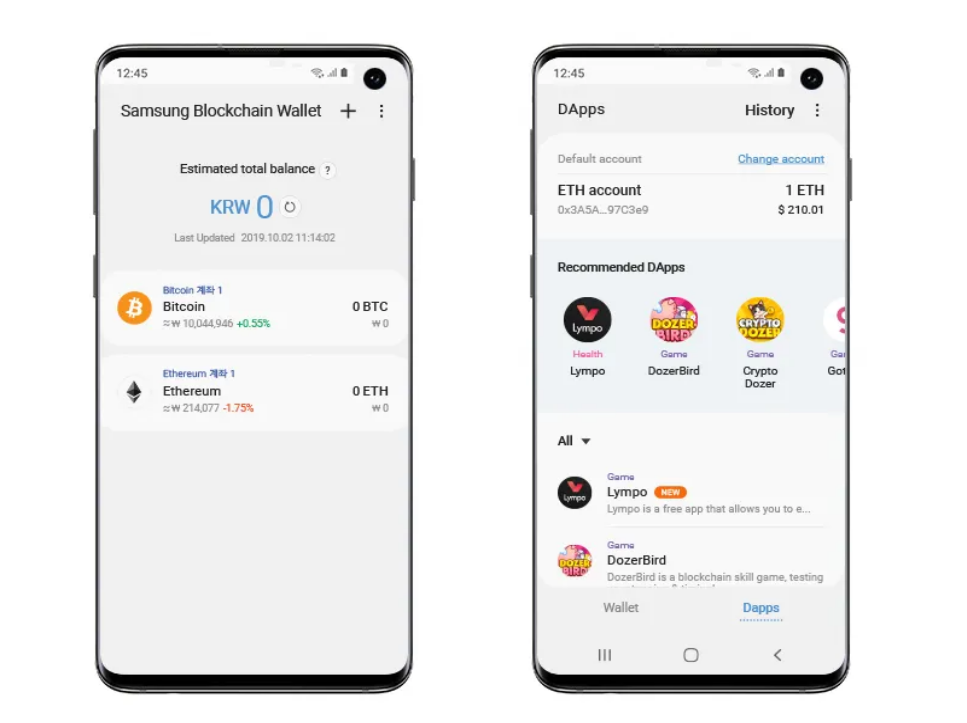
Samsung Blockchain Wallet, Source: Samsung
On the other hand, since 2019, Samsung has supported external Web3 wallet integrations, such as MetaMask and Coinbase Wallet, through its blockchain key store. It continues to support blockchain wallet applications in its latest models. Recently, Samsung collaborated with the South Korean Ministry of the Interior and Safety to launch a blockchain-based mobile ID for use with Samsung Pay. The potential adoption of Web3 technology by major smartphone manufacturers may mark a new turning point for Web3 mainstream adoption.
5. Conclusion
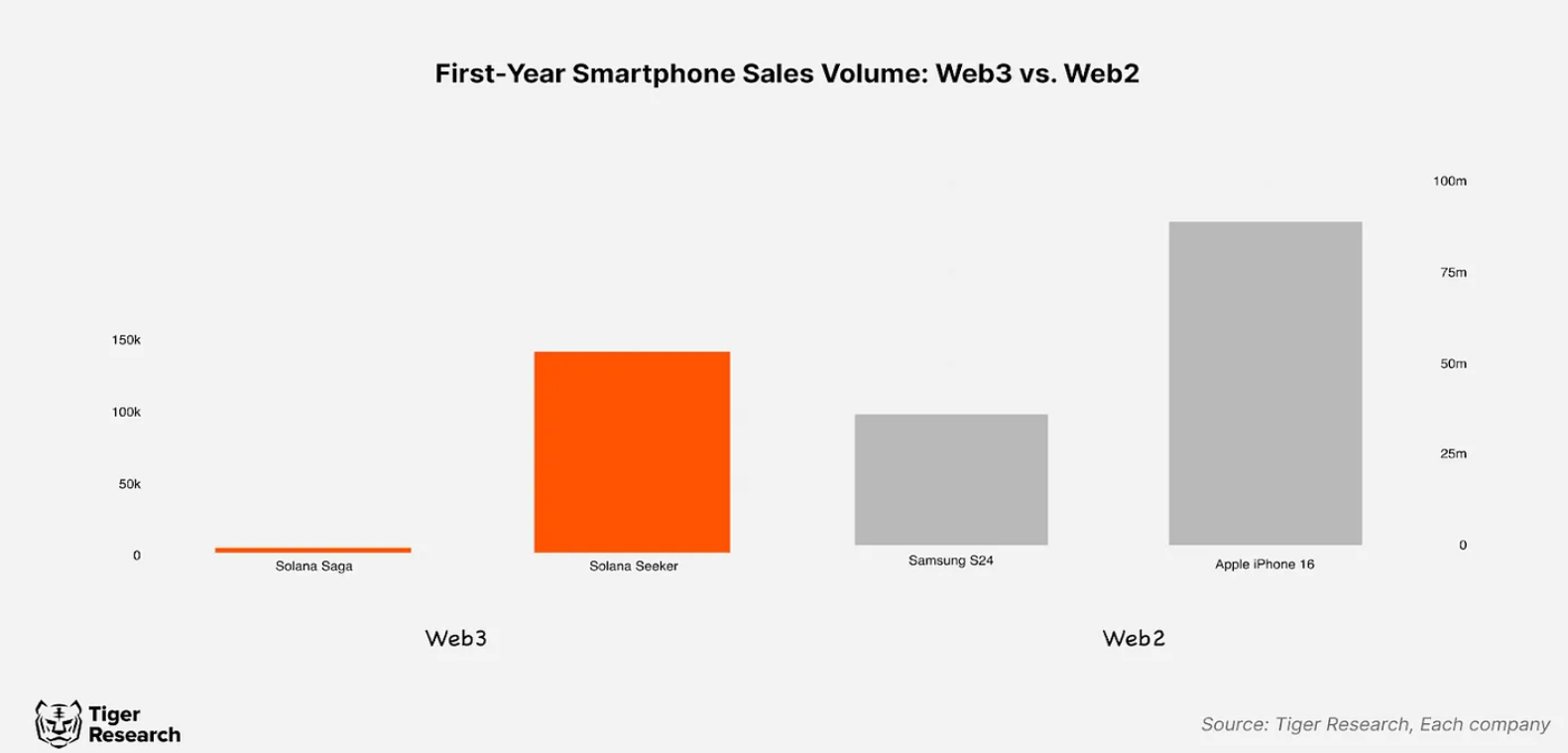
Web3 smartphones are a revolutionary concept, but the market is still in its early stages. Some projects offer token rewards and have attracted attention, but their scale remains small compared to the shipment volumes of traditional smartphones. The global smartphone penetration rate is 6.4 billion units, accounting for 76% of the total population. In contrast, there are only 10 million Web3 users, making up just 0.156% of all smartphone users. Given that the Web3 industry itself has not yet achieved mainstream adoption, the limitations of the Web3 smartphone market are even more apparent.
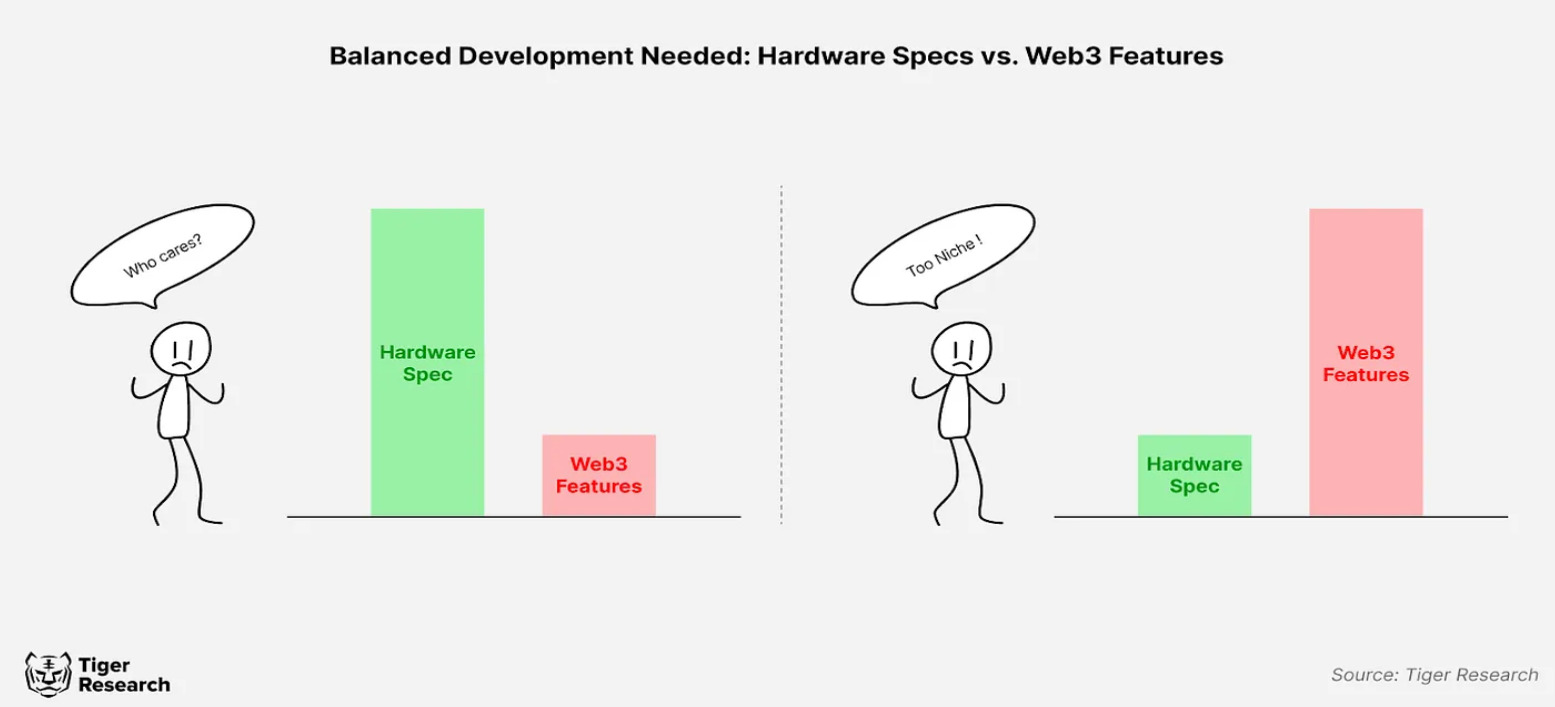
Moreover, Web3 smartphones also face significant technical limitations. They have a considerable gap in hardware performance and production capacity compared to traditional smartphone manufacturers. In this context, Web3 smartphone projects will inevitably seek long-term partnerships with established phone manufacturers. By leveraging these manufacturers' advantages in operating systems and software interfaces, Web3 smartphone projects may complement the hardware expertise of traditional manufacturers, similar to the relationship between Android and Samsung. Although challenges such as building a user-friendly decentralized application (dApp) ecosystem remain, the combination of traditional manufacturers' hardware capabilities with Web3 projects' software expertise could accelerate the development of Web3 smartphones.
Article link: https://www.hellobtc.com/kp/du/10/5495.html
Source: https://reports.tiger-research.com/p/2024-web3-smartphone-eng?utmsource=%2Finbox&utmmedium=reader2
免责声明:本文章仅代表作者个人观点,不代表本平台的立场和观点。本文章仅供信息分享,不构成对任何人的任何投资建议。用户与作者之间的任何争议,与本平台无关。如网页中刊载的文章或图片涉及侵权,请提供相关的权利证明和身份证明发送邮件到support@aicoin.com,本平台相关工作人员将会进行核查。




